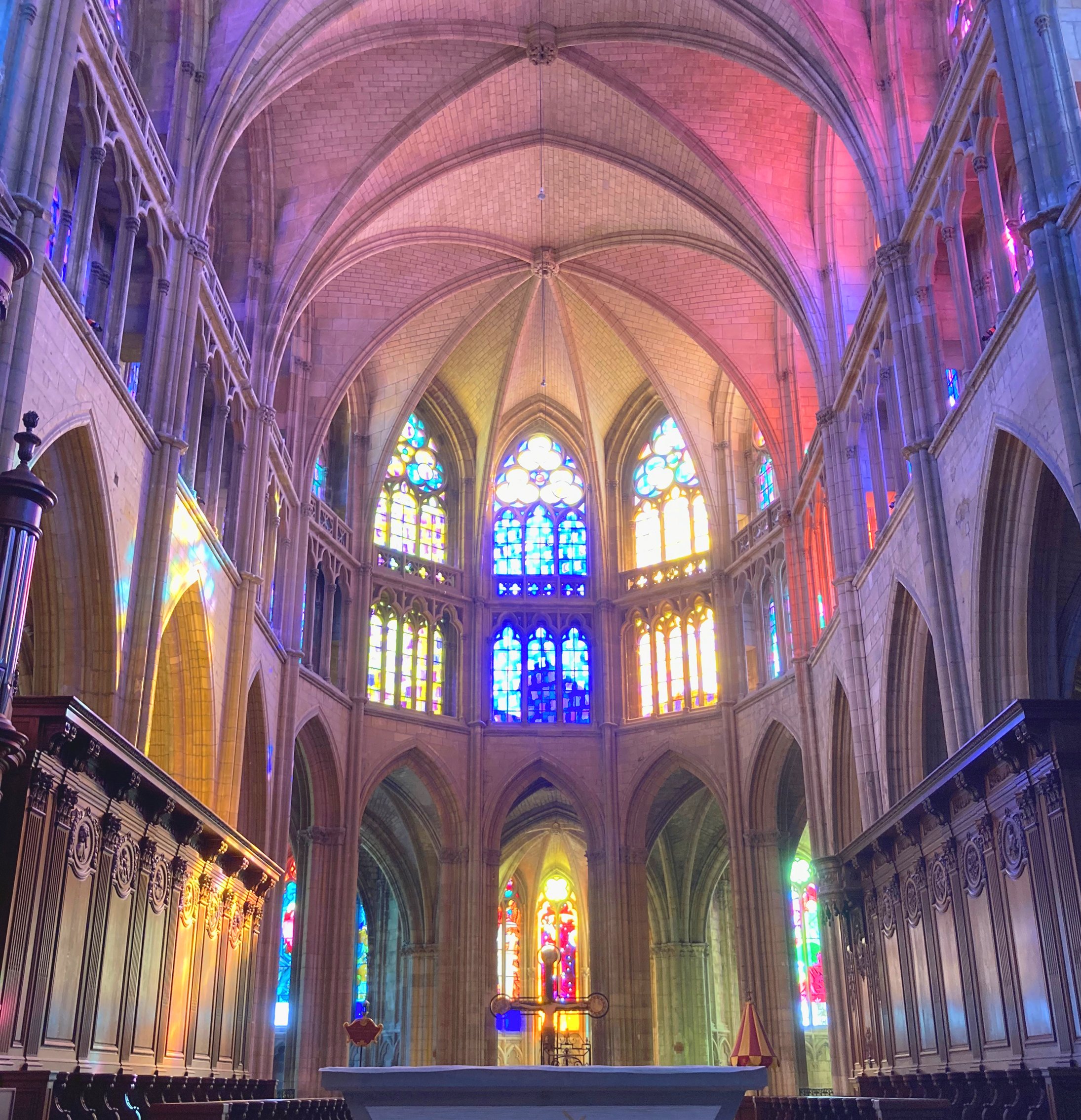Above and below: Church of St Martin, Romilly-sur-Seine. Windows by Joël Mône.
For our last day of stained glass sight seeing in France we chose, from another excellent tourist leaflet complete with map, two churches with windows made in the twenty first century. The large church of St. Martin in Romilly-sur-Seine has a series of windows by Joël Mône above what looks like a huge layer of bird netting. There is a very effective white, textured one above the west door, and a spectrum of coloured windows from yellow to red (in the south transept) through pink and purple to blue (in the north transept) and finally to turquoise and green. The colour sequence is interrupted by nineteenth century stained glass windows around the apse and, as you can see in the photos where similar glass can be seen in the lower windows of the church, the new windows sit well with the old ones by not imitating them in any way.
St. Martin, Romilly-sur-Seine, with blue window representing the baptism of Christ in the centre.
Initially I found the new windows, installed in 2013, uninteresting and the concept of the rainbow colours clichéd. In the church was a diagram that explained the sequence in terms of water and light at the green and yellow ends (cliché upon cliché) with each window linked to a bible story in the traditional way, starting with the old testament at the west and ending with the new testament either side of the altar. Now that I look at the window designs in more detail next to the verses that inspired them, I am more appreciative of the scheme and the attempt to interpret the words of the bible in an abstract manner.
Church of St Peter and St Paul, Villenauxe-la-Grande. Windows on the south side by David Tremlett.
Our last stop was Villenauxe-la-Grande, and a scheme of windows - all the glazing in the church of St Peter and St Paul - by the British artist David Tremlett that I’ve wanted to see since I read an article about them in 2005 when they were installed. 200 square metres of glass over 25 windows makes this the most significant church commission in France for twenty years, according to the leaflet. David Tremlett had not designed much for stained glass before he won this commission which was executed by the studio of Simon Marq in Reims, but this typically French stained glass system, where an artist is paired with a master stained glass maker, works perfectly here, as indeed it does in many of the churches we’ve visited on this trip.
Villenauxe-la-Grande. Windows on the north side by David Tremlett.
I think of these windows as giant watercolours, they are opalescent rather than transparent, with white lines bordering colours that remind you of the edge of a piece of paper. There is a bewildering variety of design but a consistency of scale and technique, Tremlett says that he wants each window to relate to the next one, but also to stand on its own. I imagine how satisfied the artist would have felt on seeing the commission completed - daring, original and seeming to add light to the interior with a wonderful range of light, bright colours.
Villenauxe-la-Grande. Left: Window 2 (Christ). Right: Windows 4 (Christ), windows 6 & 8 (the vine).
I chose as my favourite window no 2 in the scheme (above left), which with its pair, represents Christ. I had to keep blocking the next two windows out of my vision (above right) their spottiness represents to me the worst aspects of decorativeness - what was he thinking of? The diagram of the windows, spookily similar to the one in the church at Romilly-sur-Seine, says they represent the vine. The subject matter for the other windows goes from earth, through fire, ceramic (for the benefactor of the windows) to the virgin Mary, the paschal mystery, Christ, air and water.
Villenauxe-la-Grande. Left: Window 9 (fire), windows 7 & 5 (ceramic). Right: Windows 3 & 1 (The Virgin Mary).
Villenauxe-la-Grande. Left: Window 12 (air), windows 14 & 16 (water). Right: Windows 20 & 22 at the south west corner.
This was my favourite stained glass interior of all the ones we visited on this trip - see my last four blog posts for comparisons. I knew I would like the designs and the differences between the windows, but the success of stained glass windows, their luminosity, colour and detail, depend on their manufacture and in this case they were made by the best there is. I thought a view of the outside of the windows would give a clue as to how they’re made (below), it’s also interesting to see the wire mesh over them all that is hardly visible from the inside and to see the colour of the sky - the even northern french light that is perfect for the viewing of stained glass.
Villenauxe-la-Grande, windows 7 and 3 from the outside.


































